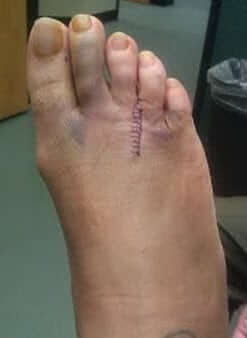A stump neuroma is a result of a detached nerve, which shapes into a stump or ball. It is an abnormal nerve growth, which in some patients is extremely painful while in others it shows no symptoms. A stump neuroma is caused due to nerve injuries and there are numerous treatments available for it.
Amputations or removing of certain body limbs might result in stump neuromas as the surgeon is forced to cut some nerves during the operation. Similarly, nerve surgeries along with severe never injuries can also cause nerves to be separated, which can lead to a stump neuroma. When nerves are cut or detached, the inner body mechanism of the nerve growth factor will cause some re-growth of the cut nerve. However, nerve cells are grown back in a disordered manner, creating a lumped mass of nerve threads. These functional nervous threads can begin conveying pain to the brain.

After Morton’s neuroma surgery
A stump neuroma from Morton’s neuroma surgery occurs in the foot resulting from the surgery which removed the Morton’s neuroma. It is a nerve disorder, which leads to extreme irritation and swelling in foot nerves and can be extremely painful. During the surgery, the nerve is cut and this can lead to a small growth from the end of the nerve – a ball of nervous tissue, which is known as a Morton’s stump neuroma. It is also called a “recurrent neuroma” as it is a reoccurrence of the initial Morton’s neuroma and it may also be referred to as a “failed Morton’s neuroma surgery”.
Morton’s stump neuroma can be a source of great pain for patients. Any type of mild or low pressure exerted on Morton’s stump neuroma can cause pain, which even includes brushing of clothes against the affected site.
A well-placed nerve block (under ultrasound guidance) with local anesthetic can also be used as an effective diagnostic test for Morton’s stump neuroma to see if a procedure can significantly reduce the severity of the pain and increase the level of comfort. This method is not a treatment but can decrease the pain and is a good indicator to see if a procedure is a suitable treatment for your stump neuroma.
For more information on Morton’s stump neuromas click here.


By providing us with your information you are consenting to the collection and use of your information in accordance with our Terms of Service and Privacy Policy.